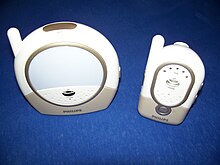Baby monitor
A baby monitor or baby monitor is a device used to monitor babies and toddlers acoustically. It usually consists of a transmitter that picks up the noises in the children's room with a microphone and transmits it to a mobile receiver using radio technology, more rarely with its own wire or wire radio . This emits the noises over a loudspeaker so that parents or other supervisors can react to them. Devices that work with wire radio do not use radio waves to transmit the signals , but the power grid as a carrier frequency system .

application
The main area of application is to monitor the sleep of babies and children from other rooms and to hear their crying immediately. So that a night watch does not have to constantly monitor several recipients in homes and other institutions, several rooms can be monitored and controlled centrally via a computer.
As a rule, baby monitors also show the noise intensity in the children's room optically, for example by means of a row of light-emitting diodes . This enables monitoring even in a noisy environment, for example when watching TV or listening to music. Parents with hearing impairments also benefit from it. There are also baby monitors with a vibration alarm for them .
Simple baby monitors are unidirectional ; that is, the device on the child's bed sends, the parent device receives.
In order to extend the service life of the batteries and to reduce possible impairments in the context of electromagnetic environmental compatibility , baby monitors usually send sound-activated by means of an automatic switch-on . The device only switches on when there is a certain noise level. In many models, a constantly transmitted pilot signal ensures reduced interference and makes it possible to detect that the reception range has been exceeded.
A use for monitoring people in need of care in a manner similar to that used for babies is not the actual purpose of a baby monitor, but these are occasionally used for this purpose.
Technical characteristics
Analogue radio baby monitors have only a few possible channels (1 to 8) and can therefore interfere with other devices and can be eavesdropped from outside because they are unencrypted. One often receives signals from the neighbors. The sound quality is sometimes very poor.
Digitally wireless baby monitors based on DECT technology (like digital cordless telephones ) have a very good sound quality and are largely interference-proof and bug-proof.
Some baby monitors allow bidirectional use, i.e. speaking to the baby. Baby monitors with cameras are also available; the receiver then either has a small screen or can be connected to the TV set.
Meanwhile converted are PMR -Funkgeräte with room monitor available. On the one hand, these have a very good range (in the kilometer range) and, on the other hand, are fully-fledged radios that allow alternative use as a walkie-talkie . The connection can be tested by pressing a button on the parent device. This eliminates the need for a pilot tone, but is still occasionally used to improve interference security.
There are also baby monitors with motion sensors that sound an alarm if there is no breathing movement , especially for children who are at particular risk of sudden infant death . Various epidemiological studies have not been able to provide any evidence that the frequency of sudden infant death syndrome can be influenced by surveillance measures. The American Academy of Pediatrics therefore gives a clear recommendation that heart-breath monitors should not be prescribed for the prevention of sudden infant death syndrome.
literature
- Andrea Mihm: Baby monitor. On the same wavelength as the child. A little cultural history . Jonas Verlag , Marburg 2008, ISBN 978-3-89445-397-8 .
Individual evidence
- ^ M. MacKay et al .: Home monitoring for central apnea. In: Arch Dis Child . 1984; 59: 136-142.
- ^ SL Ward et al .: Sudden infant death syndrome in infants evaluated by apnea programs in California. In: Pediatrics 1986; 77: 451-458.
- ^ American Academy of Pediatrics, Committee on Fetus and Newborn: Apnea, Sudden Infant Death Syndrome, and Home Monitoring. In: Pediatrics 2003; 4: 914-916.